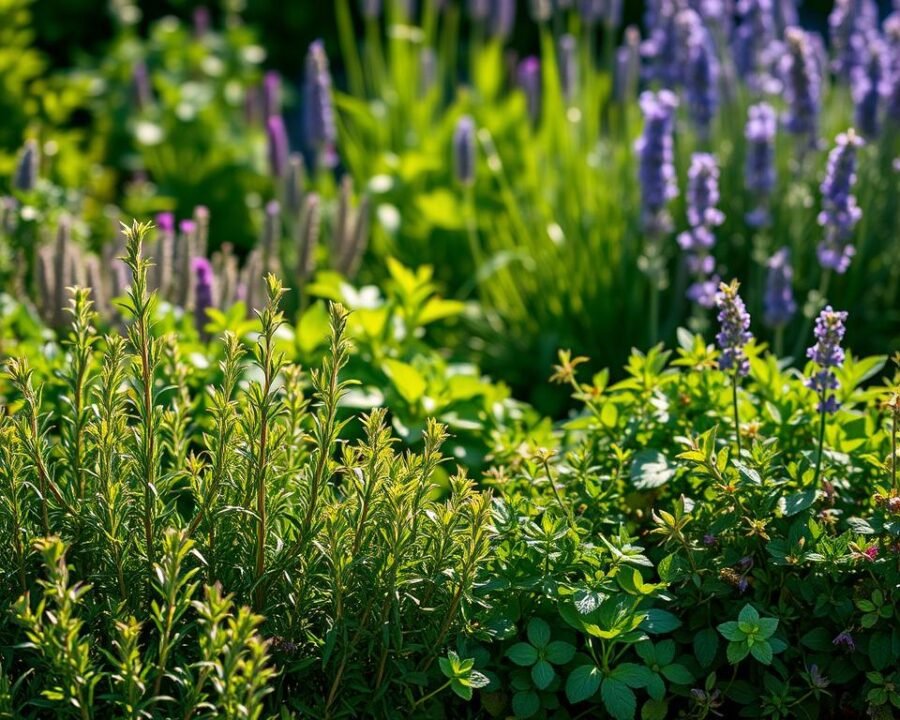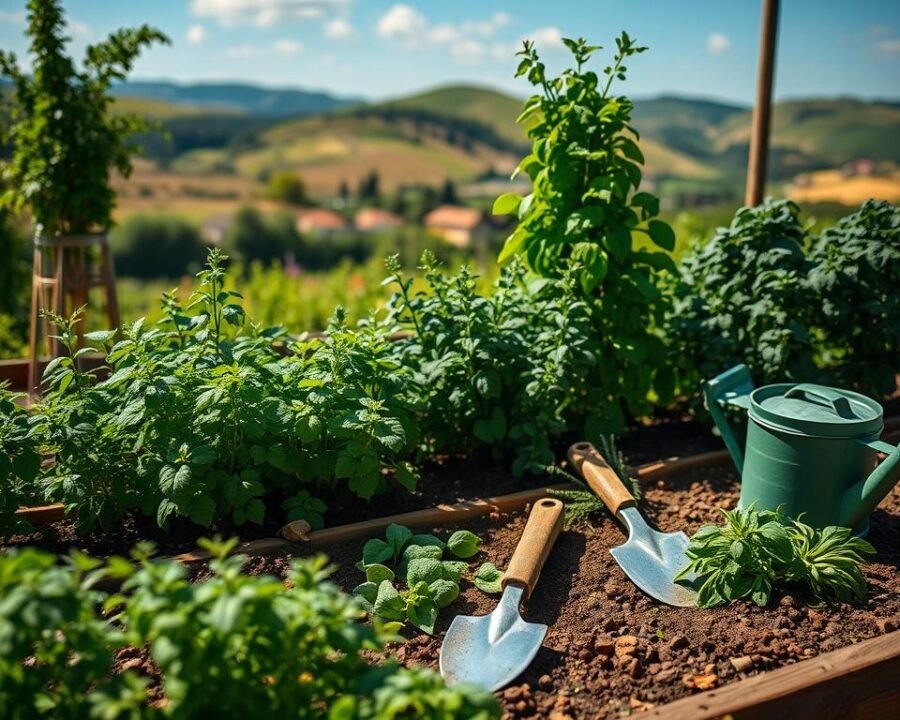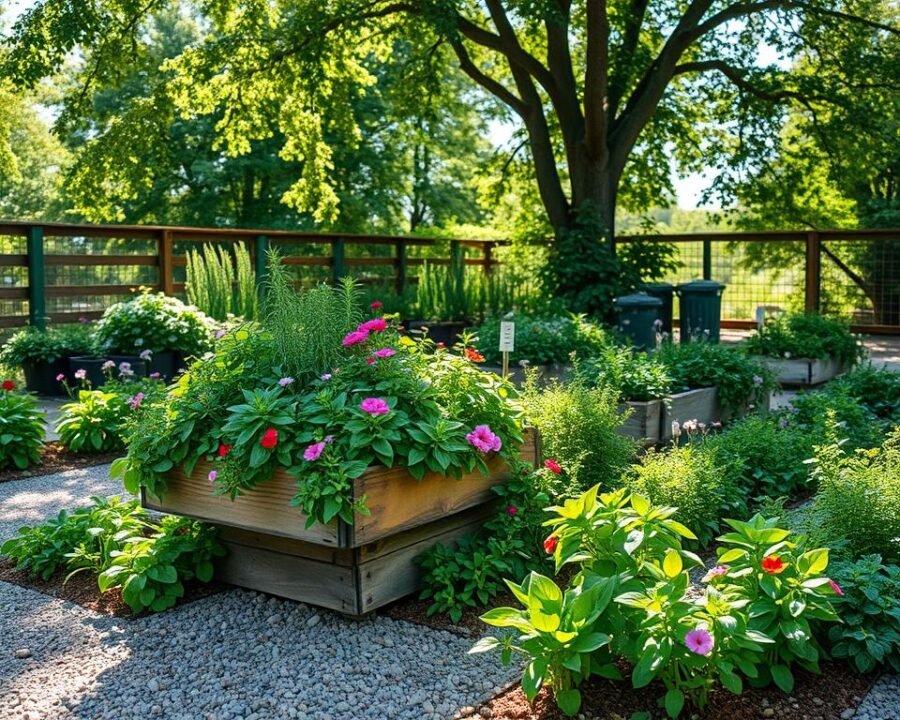There’s something magical about stepping outside and snipping fresh herbs for a meal. The scent of basil, the crispness of mint—it turns cooking into an experience. Whether you have a spacious backyard or a tiny balcony, growing your own flavorful plants is easier than you think.
Master gardener and wild forager Brianne Dela Cruz shares her secrets for success. With years of Brooklyn gardening experience, she’ll guide you through sunlight checks, container choices, and soil prep. We’ve also included perennial and annual picks to keep your space thriving all year.
From urban patios to suburban plots, our tips work anywhere. Plus, discover creative ways to use your harvest in the kitchen. Ready to grow? Let’s dig in!
Key Takeaways
- Expert advice for setting up a thriving space with herbs.
- Tips on sunlight, containers, and soil from a master gardener.
- Includes both perennial and annual plant recommendations.
- Practical guidance for urban and suburban growers.
- Ideas for using homegrown flavors in everyday cooking.
1. Assess Your Garden’s Sunlight and Space
Sunlight plays a starring role in growing vibrant, flavorful plants. Whether you’re working with a balcony or backyard, matching herbs to their ideal light conditions ensures success. Start by tracking patterns over a few days—note how shadows move and where rays linger.
Full Sun Patios (6–8 Hours)
South- or west-facing spaces get intense afternoon light. Sage and oregano thrive here but may need shade cloths to prevent scorching. Cement surfaces reflect heat, increasing water needs—Brianne waters twice daily in summer.
Partially Sunny Patios (Morning Sun)
East- or northeast-facing spots offer gentle morning rays. This location suits mixed plantings like thyme and chives. Proximity to a water source is key—containers dry faster in breezy areas.
Shady Patios (4–6 Hours)
North-facing areas work for leafy herbs like basil and parsley. If sunlight dips below 4 hours, switch to lettuces. Reflective heat from windows can create microclimates—observe closely!
| Light Condition | Recommended Herbs | Tips |
|---|---|---|
| Full Sun | Rosemary, Sage | Use shade cloths; water 2x daily |
| Partial Sun | Thyme, Chives | Morning light; check soil moisture |
| Shade | Basil, Parsley | Monitor for leggy growth |
Brianne’s pro tip: Sketch a sunlight map. Note hot spots and shady corners to optimize plant placement. Even urban patios can yield lush results with smart planning!
2. Choose the Right Containers for Your Herbs
Material and size matter more than you think when growing flavorful greens. The right pot ensures roots get enough air, water drains properly, and plants reach their full potential. Let’s break down what works—and what doesn’t.

Ideal Container Materials
Clay pots are a classic choice. Their porous nature lets roots breathe and prevents waterlogging. Terra cotta also avoids chemical leaching, keeping soil clean. Just note they dry out faster—perfect for Mediterranean herbs like rosemary.
Plastic containers are lightweight and cheap but trap heat and moisture. Use them for moisture-loving plants like mint, but avoid dark colors in sunny spots. Always check for drainage holes!
Container Size and Depth Requirements
Roots need space to spread. Most herbs thrive in pots at least 12″ deep. Perennials like sage demand 16″+ to accommodate their extensive root systems. Match the pot size to the plant’s mature width to avoid cramped growth.
- Group pots for efficient watering—drip irrigation works wonders.
- Skip decorative containers without drainage; they’re a recipe for root rot.
- Brooklyn gardeners swear by movable planters to chase sunlight.
For small spaces, try vertical planters or stackable pots. Heavy planters? Add wheels for easy rearranging. With the right foundation, your plants will reward you with lush, aromatic leaves all season.
3. Select the Best Soil for Herb Growth
Healthy roots start with the right foundation. Unlike ornamental plants, edibles demand nutrient-rich blends that support both flavor and growth. The perfect mix balances drainage, aeration, and organic matter—key factors for thriving plants.
Organic Potting Soil vs. Compost Mix
Not all soils work for culinary plants. Vegetable-specific blends often outperform generic potting mixes. Look for OMRI-certified organic options, which avoid synthetic additives. Brianne swears by a ¾ soil to ¼ compost ratio for optimal fertility.
Here’s why this combo wins:
- Sandy loam base prevents waterlogging while retaining moisture
- Compost introduces beneficial microbes and slow-release nutrients
- Perlite or vermiculite boosts aeration for delicate root systems
Avoid soils labeled for flowers—they often lack the nitrogen herbs crave. For container plants, lightweight mixes with peat moss work well. Always check pH levels; most herbs prefer slightly acidic conditions (6.1–7.0).
Soil Refreshing and Repotting Tips
Even premium blends lose nutrients over time. Refresh containers annually by topping with fresh compost. Perennials like rosemary need repotting every 2–3 years to prevent root binding.
Watch for these signs it’s time to repot:
- Salt crusts on soil surface
- Stunted growth despite proper care
- Water pooling instead of absorbing
Brooklyn gardeners overwinter plants by refreshing soil in fall. They also recommend testing soil pH each spring. Simple DIY tests reveal when to add lime or sulfur for balance.
Never reuse depleted soils—they harbor diseases and lack vitality. Instead, recycle old mix into compost piles. With proper care, your plants will reward you with robust growth and intense flavors.
4. Pick the Best Herbs for Your Garden
Choosing the right plants can transform your space into a fragrant, productive oasis. Whether you prefer woody perennials or tender annuals, each variety brings unique flavors and textures. Let’s explore top picks that thrive in different conditions.

Perennial Herbs: Rosemary, Sage, Thyme
These hardy plants return year after year with minimal fuss. Rosemary loves dry, sunny spots and resists pests naturally. Its woody stems add structure to any arrangement.
Sage offers velvety leaves perfect for roasting. Plant it in well-draining soil and avoid overwatering. Brooklyn gardeners recommend pruning after flowering to maintain shape.
For ground cover, thyme spreads beautifully between stones. Its tiny leaves pack intense flavor. Give each plant 12″ of space to prevent overcrowding.
Annual Herbs: Basil, Parsley, Cilantro
These fast-growing favorites need replanting each season. Basil thrives in warm weather—sow seeds after frost danger passes. Pinch flowers to delay bolting.
Parsley grows well in partial shade. Its curly or flat-leaf varieties both enhance dishes. Start seeds indoors 10 weeks before transplanting.
Cilantro bolts quickly in heat. Succession plant every 3 weeks for continuous harvest. Pair it with cool-weather flowers for visual appeal.
Edible Flowers for Companion Planting
Bright blooms do more than look pretty—they attract pollinators. Nasturtiums deter aphids while adding peppery zest to salads. Calendula petals brighten rice dishes.
For pesto variations, try blending chive blossoms with basil. Their purple flowers add mild onion flavor. Always verify a flower’s edibility before consumption.
- Source plants from local nurseries for healthier starts
- Baker Creek and High Mowing offer organic seeds
- Avoid big-box store plants—they often carry pests
- Divide perennials every 3 years to rejuvenate growth
- Overwinter rosemary indoors near sunny windows
With thoughtful selection, your space will yield abundant flavors. Match plants to your light conditions and cooking preferences for maximum success.
5. Care for Your Herb Garden Like a Pro
Keeping plants thriving requires more than just sunlight and soil—it’s about consistent care. Master these techniques to ensure robust growth and intense flavors all season.

Watering Frequency and Techniques
Timing matters. Early morning watering reduces evaporation and prevents fungal issues. For accuracy, use the finger-test: insert a finger 1″ deep—if dry, it’s time to hydrate.
Containers dry faster in heat or wind. Cement patios amplify warmth, so Brooklyn gardeners water twice daily in summer. Group pots to streamline the process.
Natural Fertilizers and Feeding Schedule
Plants crave nutrients every 3–4 weeks. Fish emulsion, a gardener favorite, offers a quick nitrogen boost. Apply it in the evening to avoid leaf burn.
Liquid fertilizers absorb faster than granular ones. For foliar feeding, spray diluted mixes directly onto leaves. Always follow label instructions to prevent overfeeding.
Pruning and Deadheading for Bushier Growth
Regular trimming prevents leggy stems. Cut just above leaf nodes to encourage branching. For basil, pinch off flower buds to prolong leaf production.
Deadheading—removing spent blooms—redirects energy into new growth. Woody herbs like rosemary benefit from light shaping after flowering.
- Rotate pots weekly for even sun exposure.
- Avoid midday fertilizing—roots absorb nutrients better in cooler temps.
- Refresh mulch to retain moisture and regulate soil temperature.
6. Harvest and Enjoy Your Homegrown Herbs
Nothing compares to the satisfaction of using freshly picked leaves in your kitchen. Timing, technique, and creativity turn a simple harvest into culinary magic. Let’s explore how to maximize flavor and extend your bounty beyond the growing season.
Perfect Timing for Peak Flavor
Morning is prime time for picking. Plants retain essential oils before the sun evaporates them. For annuals like basil, harvest just before flowering—this is when leaves taste sweetest.
Use sharp scissors for clean cuts. Snip stems at a 45° angle to promote regrowth. Avoid removing more than ⅓ of the plant at once. Woody perennials like rosemary handle harder pruning after blooming.
- Leafy types: Pinch from the top to encourage bushiness
- Flowering varieties: Collect blossoms when fully open
- Seed crops: Wait until seed heads turn brown
Preserving Your Bounty
Extend the season with proper storage. Air-drying works best for sturdy stems—hang small bunches upside down in a dark, ventilated space. Brianne uses a simple rack with twine in her pantry.
For tender leaves like parsley:
- Rinse and pat dry immediately
- Wrap in slightly damp paper towels
- Store in airtight containers for up to 2 weeks
Culinary Creativity
Fresh flavors elevate everyday meals. Try these simple ideas:
- Compound butters: Mix chopped chives or thyme into softened butter
- Herb oils: Steep rosemary or garlic in olive oil for 2 weeks
- Flower garnishes: Sprinkle calendula petals over salads
- Frozen pesto: Portion basil blends in ice cube trays
- Tea blends: Dry mint with lemon verbena for soothing brews
For more inspiration, explore these versatile culinary herbs that transform ordinary dishes. Remember—the most intense flavors come from plants harvested at their peak and used soon after picking.
With these techniques, your homegrown harvest will bring restaurant-quality flavors to every meal. Whether fresh, dried, or preserved, these aromatic treasures make cooking an adventure.
Conclusion
Growing flavorful plants at home brings joy and freshness to every season. Start small with 3-5 varieties, focusing on sunlight and space. Microclimates matter—adjust care based on your unique conditions.
Share cuttings with neighbors or swap seeds locally. Organic practices keep plants healthy and chemical-free. For more tips, explore our upcoming guides.
We’d love to see your thriving green space! Tag us on social media with your success stories. Whether it’s a windowsill or backyard plot, every harvest counts.
Our favorite part? Watching those first leaves sprout. Happy gardening!
